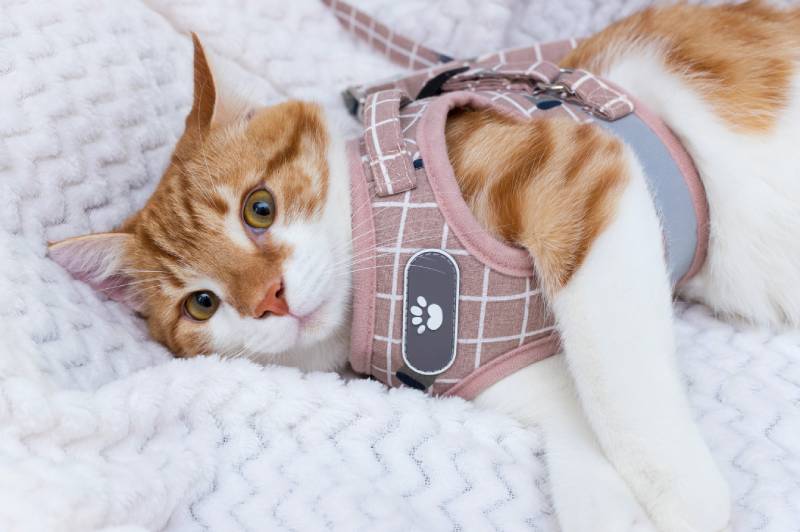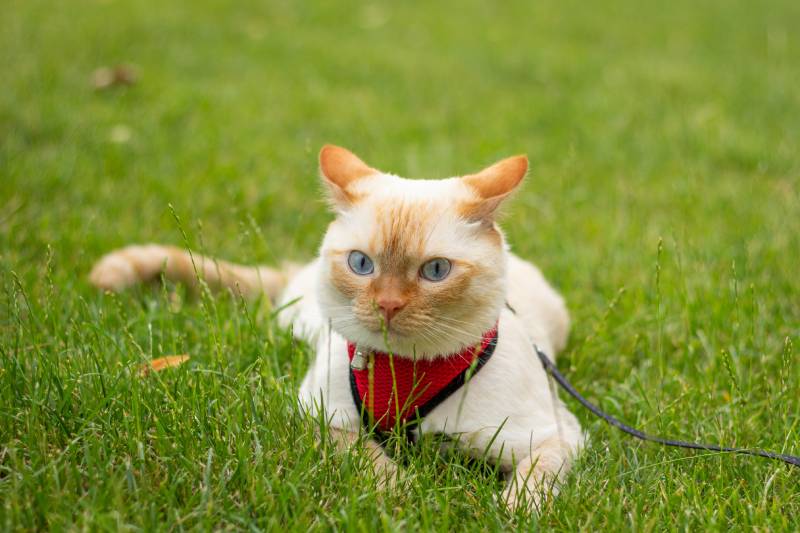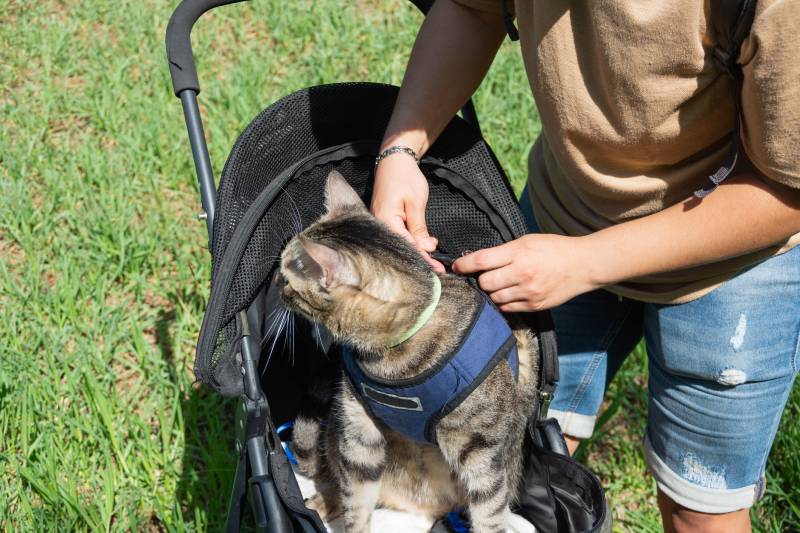
Cats are more in touch with their wild side than we may realize. After all, humans domesticated them only 12,000 years ago versus the roughly 40,000 years we’ve befriended dogs. Our feline companions haven’t changed a lot during this time, either, with only 13 genes changing during the process. That information is significant since it can explain seemingly odd behavior, like falling over with a harness.

Possible Causes Why Your Cat Falls Over When They Have a Harness
1. Instincts on the Job
Our pets often act instinctively, driven largely by the survival of the fittest. If a trait gave an animal a competitive edge, it could live long enough to reproduce and pass on its genes. Species at a disadvantage without this characteristic would perish. The brains of our feline companions differ from wild cats, with reductions in regions associated with reactivity, fear, and aggression.
These changes made them better suited as pets. Some are the result of overcoming their fear of living in proximity to humans. We also provided them with a reliable food source and shelter. Being nice to us also helps. A harness represents a stark departure from the basis of our relationship with felines. We usually let them do their own thing, ridding our homes of pests. Walking them is altogether different.

2. The Feline Experience
Let’s look at wearing a harness from a cat’s perspective. Moving freely is what they’re used to, as they often move stealthily, stalking prey. Climbing into boxes for security is one thing since they choose to do it; putting them in a harness is another matter 1. It feels confining to the animal put in an unfamiliar situation. Escaping is instinctive. Survival is sometimes dependent on being cautious.
Our pets are descendants of the African Wild Cat. While they are predators, they are also on the short end of the stick as prey. Wolves, coyotes, and raptors readily kill young felines. One survival strategy some animals use is to play dead. The goal is that a predator would drop them and give them a chance to escape. It’s a long shot, but possible.
The other situation occurs between the mother and her kittens. When she wants to move them, she grabs the young in her mouth by the scruff of their neck. Again, we’re talking about an instinctive response to go limp. Fighting their mother could endanger their lives. It’s safer to go with the flow. After all, Mom always knows best.
When your cat falls over when you snap on the harness, they are acting instinctively, whether it’s survival or their mother taking charge. It’s a natural response to an unnatural scenario.

Getting Your Cat Used to a Harness
It’s essential to get a harness made for a cat and not a dog. The varying body shapes will make it easy for a feline to slip a canine product. They look distinctively different if you compare them side by side. The next step is to let your kitty make the call. Let them investigate the harness on their own time. A cat will naturally back away from something new. Allow your pet to sniff and examine the item first.
Your cat will be less likely to run from you when you bring out the harness if they know about the object on their terms. Make sure you have special treats on hand when it comes time to slip it on your cat. Felines are usually food-motivated. We suggest using something yummy they’ll only get when using the harness. You may find your pet is less likely to bolt and more tolerant of the harness.
Place the harness on your cat’s body without tightening it. Don’t forget the treats. You have to overcome thousands of years of evolution. It’s going to take time and patience. Read your pet’s body language and respond accordingly. Don’t force your kitty to go along with your scheme. Strive to make it a positive experience so that you can take the next steps.
Cats are intelligent. They just need to learn that wearing a harness isn’t a bad thing. They’ll likely welcome it if it means a walk outside and all the mental stimulation it provides. Of course, it’s better to start the process with a kitten than an adult. However, it’s not impossible. Follow your pet’s lead and stick with it. However, if they object too much, don’t hesitate to throw in the towel.


Final Thoughts
Wearing a harness isn’t a natural thing for cats. Instincts kick in and guide their behavior. Your pet will likely lie down because their body is equating it with capture by a predator or their mother taking them by the scruff of the neck. Their response is adaptive and makes evolutionary sense. It can reduce the risk of injury or worse by responding this way.
If you want to train your pet to wear a harness, it’s essential to be patient and try to make it a positive experience. Treats can work wonders. Let your kitty guide the process for the best chances of success.
Featured Image Credit: olya_foto, Shutterstock

